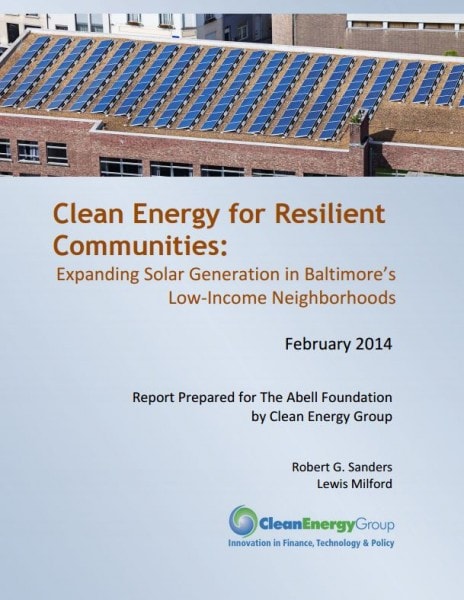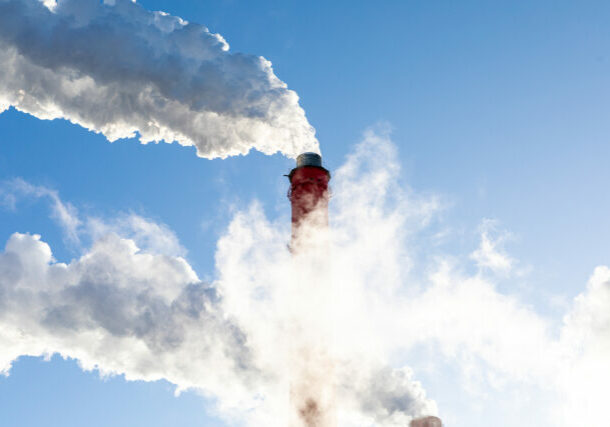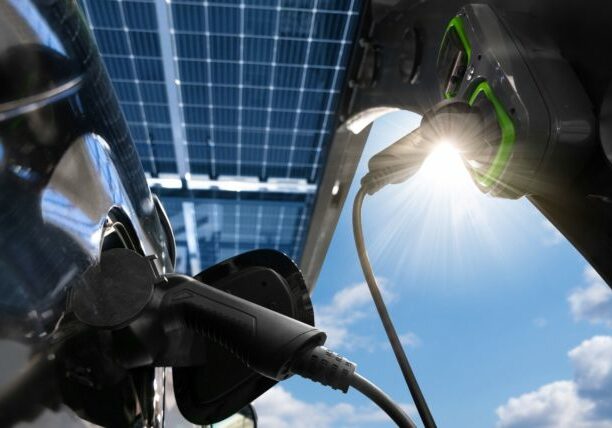February 12, 2014
Clean Energy for Resilient Communities
By Lewis Milford

In the first blueprint of how a city could become more “power resilient,” the report, Clean Energy for Resilient Communities, shows how Baltimore and other cities could use clean energy to create a more reliable electric system that protects vulnerable citizens during power blackouts.
The report was written by Clean Energy Group for The Abell Foundation, a leading private foundation in Baltimore.
The report starts out with some basic assumptions:
- Building stronger and more resilient local communities has always been at the core of community development. It aims to overcome poverty and disadvantage by investing in the physical infrastructure of neighborhoods, building family income and wealth, improving access to quality education, and promoting social equity.
- Adding to the well-known and pervasive challenges to community well-being are new threats brought on by climate change, which can impact especially the most vulnerable among us—the poor, the elderly, and the disabled.
- For millions of people in the East, Superstorm Sandy and the derecho of 2012 have now changed the definition of what a resilient community is and needs to be.
- Resilient communities need resilient power. Without dependable power, a community can be brought to its knees. Extreme weather events and resulting power outages deprive a community of its most basic need—the electricity that makes the multiple levels of urban infrastructure, economic activity, and social interdependence possible.
- All infrastructure systems are vulnerable to power disruptions, whether they are buildings, utilities, gasoline, health care, telecommunications, transportation, water and wastewater, food supply, solid waste—and public safety. All rely on electricity, which is the community’s lifeblood.
We have learned from recent extreme weather events that a community without dependable and reliable power is a community at risk. The consequences of losing power are stark, especially for low-income residents, the elderly, and disabled.
The damage and harm caused by storms are always compounded by poverty. Low-income areas have more difficulty responding and recovering from the destruction caused by extreme weather events and related power outages. They often lack the income, savings, jobs, access to communication channels and information, and insurance to recover from the adverse impacts of extreme weather events.
These dangers are often forgotten after the immediate damage from these events is over. But public agencies concerned with the health and welfare of its most vulnerable residents must come to realize that these impacts are not inevitable; they can be prevented. And they should also realize they might have legal obligations under the Americans with Disabilities Act to do more to ensure the disabled and the elderly have access to facilities in emergencies, which is denied to them if power is not on. A court has ruled that New York City violated their rights when power was out during Hurricane Sandy.
The report is designed to explore some basic issues:
- How solar technologies can help the poor, the disabled and the elderly with their day-to-day lives, especially in the face of threats from more frequent extreme weather events in the future.
- How solar, configured with battery storage, can help protect lives by keeping the elevators running and the air conditioner on in senior centers and housing during a power outage.
- How clean resilient power can help reduce the risk of heat stroke and hypothermia in vulnerable populations during power emergencies and extreme weather events.
- How public facilities like schools can be powered by solar power with battery storage, or other forms of clean energy generation, to serve as emergency shelters.
- How cities can ensure that critical public facilities like shelters, emergency centers, and police and fire stations are equipped with more reliable power to withstand the next storm.
- How public policies and utility support programs can be targeted to provide opportunities in low-income communities for distributed solar generation and community power resiliency.
- How these new measures to protect vulnerable populations from power outages also provide a public health benefit by reducing the environmental impacts of conventional electricity generation on low-income communities.
The reports offers many specific recommendations as to how a city could become more power resilient.
Our key solution is clean energy, especially distributed solar with battery storage, which can keep solar up and running in a power outage. Solar with storage can be a useful community development tool to create community power resiliency, while at the same time leveraging public and private investment in low-income communities.
This focus on power resiliency comes from an examination of what are the best strategies to provide low-income communities with access to the benefits of solar power. We could affirm those policies that say it is better to completely subsidize the technology for low-income households, using deep subsidy to essentially give the poor solar at little or no cost. That strategy depends on heavy subsidies over the long run, which can prove to be an unreliable and unsustainable approach.
For that reason, we find it is better to align new business models that may be ready to serve those markets without deep subsidy. We believe this strategy to be more promising.
That leads us to focus on power resiliency as a way to tap into emerging business and technology markets for solar battery storage. That approach would give community buildings and schools and other facilities more power protection in the event of severe weather events. We think this approach makes more business, political, and economic sense for the communities of concern.
The report also makes many specific recommendations for how a city could adopt policies and finance these technology solutions for a more resilient community.
Most important, these recommendations could apply to any community that wants to protect its most vulnerable populations from the ravages of future severe weather events.
In the end, damage from power outages is not inevitable. We have the technologies and the business models to prevent such damage. Communities and their officials simply need to take the steps to use them to protect their citizens from harm in the future.














